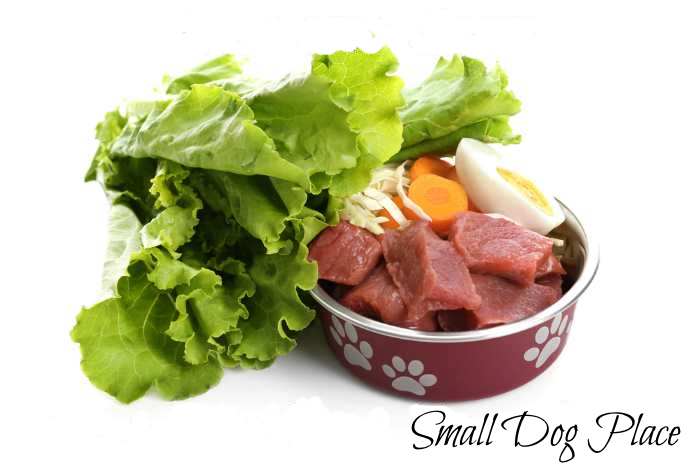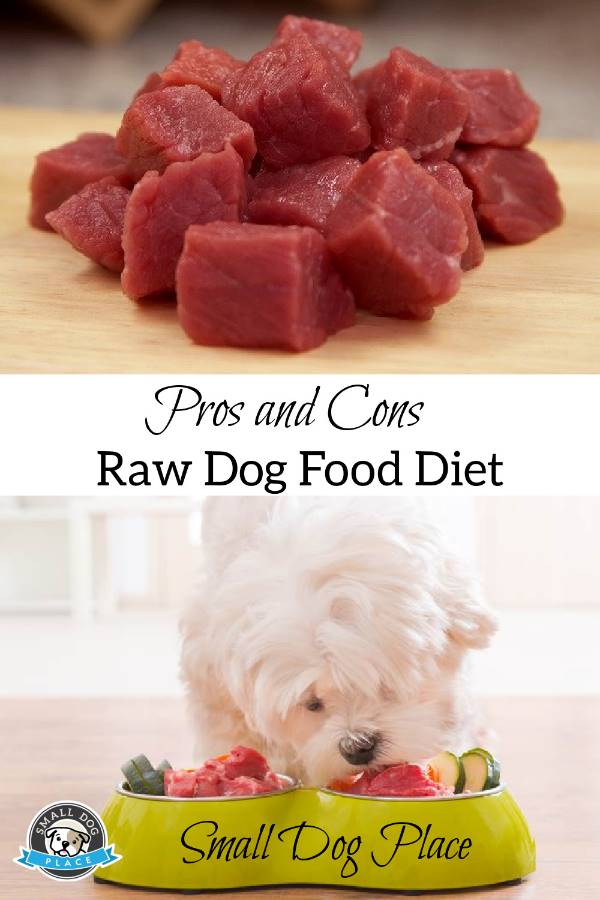- Small Dog Place Home
- Feeding
- Pros and Cons of Raw Dog Food Diet
Pros & Cons of Raw Food Dog Diet
Pros and Cons of Raw Dog Food Diet by Alisha Ashton
Updated 04-09-2024
It is natural to want the best for your pup, from the comfiest beds to the most nutritious meals.
Raw pet food diets have become much more mainstream in the last few years, with various easy-to-order pet food subscription services on the market.
If you are wondering what the benefits and downsides of a raw diet for your dog are, please read on as we discuss the pros and cons.

It is natural to want the best for your pup, from the comfiest beds to the most nutritious meals. Raw pet food diets have become much more mainstream in the last few years, with various easy-to-order pet food subscription services on the market.
If you are wondering what the benefits and downsides of a raw diet for your dog are, please read on as we discuss the pros and cons.
What Is Raw Dog Food?
As the name suggests, it means feeding your dog only raw ingredients. Any meats and other components are uncooked, unlike tinned pet food from the supermarket, which has been processed differently.
Raw ingredients include different types of meat, bones, and certain fruits and vegetables.
Raw food diets can be homemade, store-bought, or even dehydrated.
What are the downsides of a raw dog food diet?
One significant reported downside is that feeding your dog or dogs if you have multiple can be very expensive. Even if you opt for frozen or freeze-dried options, which generally tend to be cheaper, it might be too much if you are on a tight budget or have more than one or two dogs to feed.
If your budget allows for a raw food diet, consider that you might need to invest in a bigger freezer!
It is also said that it can be easy to end up with a nutritional imbalance when feeding your pooch a raw diet if you are doing homemade raw dog food.
Canine nutritionists exist for a reason, and it can be hard to ensure that dog food contains the right balance of nutrients. Raw dog food made by a dedicated manufacturer must hit certain benchmarks to ensure your dog will thrive on this type of diet.
What are the benefits of a raw dog food diet?
If your dog suffers from very smelly or loose poo, feeding your dog a raw diet might help clear up this stinky issue.
As the raw food helps create smaller and firmer stools, your dog's number twos will automatically be much less smelly. Some also report shinier coats, healthier skin, and improved energy levels.
There are some dogs with allergies and allergy symptoms. A raw food diet has been reported to help alleviate this type of issue. Do discuss these types of things with your vet first before making a swap.
Common Worries and Questions
Should I be worried about e-coli or salmonella?
You might be worried about cross-contamination or bacteria from feeding your dog raw food. You don't need to worry when buying raw dog food from a reputable source. All the food would have gone through batch testing specifically for these common bacteria. Also, their manufacturing process needs to meet specific standards to operate and safely sell their products.
If you are thinking of making your own raw dog feed, please just make sure you do your research since the risks are much higher when making your own.
Is it safe to feed your dog bones?
Some pet owners are concerned about the fact raw dog food contains bones. The bones included in raw dog food are called nutritional raw bones and will most likely be chicken bones as they are softer and hollower and, therefore, easier to grind.
For example, beef bones can be harder to grind and pose a more significant risk. Soft bones are included as they provide excellent nutrition and also help with dental care.
What changes should I expect in my dog if I switch to raw dog food?
As raw dog food contains more moisture, you will notice a decrease in their water intake. As mentioned previously, you can also expect changes in their stool.
It is generally recommended that if you decide to switch your dog over to a raw diet, this is done gradually. Their digestive system will need time to adjust; therefore, a slow transition will be most beneficial for your pup.
Some dogs will adapt faster than others, depending on their age. Generally, it can take a few days up to a few weeks.
Pros and Cons of Raw Dog Food Diet
Pin for Future Reference
Do Your Research
Many dogs thrive on a raw food diet, but dogs will equally thrive on supermarket foods. The biggest thing is to do your research.
If a raw diet is a little outside your budget or you would like to avoid the idea of a raw diet, there are dog food brands that use less filler and grains in their kibble, for example.
We have previously dedicated blog
posts to dog food. You can read more here on dog food, specifically for
small breeds. You can read more on dog nutrition for small
dogs here.
Pros and Cons of Raw Dog Food Diet
Author Bio
Alisha Ashton is a writer, blogger, and dog lover interested in canine nutrition. She is a dog mom to two sweet but spoiled fur babies. This is her first post on Small Dog Place, but we hope it won't be her last.
About Janice (author and voice behind this site)
Having lived with dogs and cats most of her life, Janice served as a veterinary technician for ten years in Maryland and twelve years as a Shih Tzu dog breeder in Ohio.
Her education includes undergraduate degrees in Psychology with a minor in biology, Early Childhood Education, and Nursing, and a master's in Mental Health Counseling.
She is a lifelong learner, a dog lover, and passionate about the welfare of animals. Her favorite breed for over 50 years has been the Shih Tzu, but she has also lived with Poodles, Maltese, Yorkshire Terriers, Beagles, English Bulldogs, Carin Terriers, and a Cocker Spaniel.
When not writing, reading, and researching dog-related topics, she likes to spend time with her eight Shih Tzu dogs, husband, and family, as well as knitting and crocheting. She is also the voice behind Miracle Shih Tzu and Smart-Knit-Crocheting
Does This Article Deserve Your Thumbs Up?
We always appreciate your support and encouragement. Your thumbs up means so much to us. Please like this article.
If you find this page or any page on Small Dog Place Helpful, or useful in anyway, I'd love it if you would click the small heart found on the bottom right of each page.
You can also share or bookmark this page -- just click on the:
Your second block of text...

Free Monthly Newsletter
Sign Up for Our Free Newsletter and get our Free Gift to You.
my E-book, The Top 10 Mistakes People Make When Choosing a Dog (and how to avoid them)


